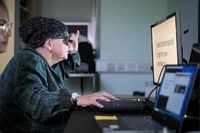In a remarkable leap forward for the visually impaired, patients once resigned to a world of darkness are now reading books, doing crosswords, and deciphering the tiny print on prescription bottles—all thanks to a pioneering bionic eye implant. The Prima system, a photovoltaic microchip measuring just 2mm by 2mm and half the thickness of a human hair, has restored central vision to those suffering from geographic atrophy (GA), an advanced stage of dry age-related macular degeneration (AMD). This breakthrough, described by experts as a “paradigm shift” in artificial vision, marks the first time that individuals with this previously untreatable condition have regained the ability to read and write through an eye that was functionally blind.
The international clinical trial, detailed in The New England Journal of Medicine and conducted at 17 sites in five countries—including the UK, France, Italy, and the Netherlands—enrolled 38 patients who had lost their central vision to GA. Among them was Sheila Irvine, a 70-year-old from Wiltshire, UK, who had been registered blind for years. Before the procedure, her world was, in her words, "like having two black discs" in her eyes, with everything outside distorted. “I was an avid bookworm, and I wanted that back,” she told the BBC. After the implant, she described the experience as “out of this world,” adding, “It’s beautiful, wonderful. It gives me such pleasure.”
The Prima device is implanted under the retina in a delicate procedure performed at Moorfields Eye Hospital in London. Surgeons first remove the eye’s clear, jelly-like substance in a process called vitrectomy, then create a trapdoor under the center of the retina to insert the chip. Once in place, the implant works in tandem with augmented-reality glasses equipped with a video camera. This camera captures the visual scene and sends information to a small computer worn on the patient’s waistband. The computer, powered by artificial intelligence, processes the visual data and converts it into electrical signals. These signals are relayed through the retina and optic nerve to the brain, where they are interpreted as sight.
This partnership between biological and digital systems is what enables “prosthetic vision.” The computer includes a zoom feature, allowing users to magnify letters and numbers. The chip itself is permanent, but the glasses can be worn as often or as little as the patient desires. As Dr. Peter Bloomfield, director of research at the Macular Society, explained to The Scotsman, “These are encouraging results which indicate an improved quality of life to patients living with dry AMD, particularly GA. Where there is currently no treatment option, this is fantastic news. Artificial vision may offer a lot of hope to many, particularly after previous disappointments in the world of dry AMD treatment.”
Once the chip is activated—typically about a month after surgery—patients undergo intensive rehabilitation to learn how to interpret the new signals and re-learn reading. The process isn’t simple, as Irvine noted: “It’s not simple learning to read again, but the more hours you put in, the more I pick up.” Yet the impact is profound. Irvine now enjoys challenging herself with reading tiny print on prescriptions, doing crosswords, and reading the ingredients on tins. She credits the team at Moorfields for encouraging her to push her limits, saying, “The team at Moorfields have given me challenges, like ‘look at your prescription,’ which is always tiny. I like challenging myself, trying to look at the little writing on tins, doing crosswords. It’s made a big difference. Reading takes you into another world. I’m definitely more optimistic.”
The social and emotional benefits are equally significant. Many patients with GA and advanced AMD experience depression and social isolation due to their vision loss. As Mahi Muqit, the Scottish consultant ophthalmic surgeon who led the UK arm of the trial, told The Scotsman, “You have to realise you’ve got blind patients who are depressed and socially isolated, who are now able to start to function and pick up things that they used to enjoy.” He described the technology as “life-changing,” adding, “We’ve got some patients who are now reading books, their quality of life is much higher. Some of them are writing, doing crossword puzzles, things they enjoy.”
The findings speak for themselves. According to the study published in The New England Journal of Medicine, 84 percent of patients using Prima were able to read letters, numbers, and words—remarkable considering some could not even see the vision chart before the implant. On average, participants could read five lines on a vision chart. The technology has been described as a “new era” in artificial vision, and Muqit is optimistic about its future: “In the history of artificial vision, this represents a new era. Blind patients are actually able to have meaningful central vision restoration, which has never been done before.”
The Prima system, developed by US-based medtech company Science Corporation, is now seeking regulatory approval. While the device is not yet licensed for use outside clinical trials, hopes are high that it will become available through the UK’s National Health Service (NHS). “I would have to say, it’s a whole paradigm shift,” Muqit told The Evening Standard. “You talk to surgeons in the UK that I’m colleagues with, and they’re all very excited by this particular technology. You know that this technology will be scalable.”
For those unfamiliar, age-related macular degeneration (AMD) is a leading cause of vision loss in older adults, affecting the macula—the central part of the retina responsible for sharp, detailed vision. Geographic atrophy, the advanced stage of dry AMD, leads to progressive loss of central vision as the macula deteriorates. Globally, GA impacts about five million people, with more than 250,000 in the UK alone. Experts estimate that around one in four people who are legally blind in the UK have GA from AMD. Symptoms range from seeing straight lines as wavy, to sensitivity to bright lights, visual hallucinations, and, ultimately, profound central vision loss.
Sheila Irvine’s story is emblematic of the resilience and hope that medical innovation can bring. Diagnosed with AMD more than 15 years ago, she lost her driving license and much of her independence, but refused to let the condition define her. “I can’t see TV very well, but I still have it on in the background. I don’t let anything stop me. I’ve got lots of friends, and I socialise quite a bit; we catch up at the pub. And this country is wonderful – I get lots of assistance with transport, I still live by myself and want to stay independent.”
For now, the Prima chip stands as a beacon of hope for millions worldwide, promising not just restored vision, but a return to the joys and independence that sight brings. As regulatory hurdles are addressed and more patients gain access, the world will be watching closely—one letter, crossword, and prescription at a time.





